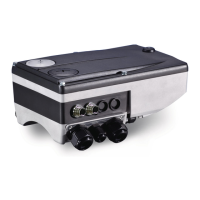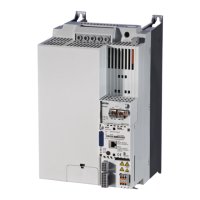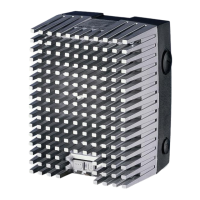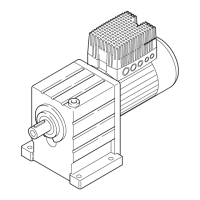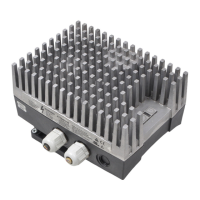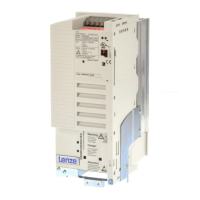Do you have a question about the Lenze 8400 motec and is the answer not in the manual?
Details the version history and changes made to the documentation across different releases.
Explains typographical conventions, symbols, and icons used throughout the manual for clarity.
Defines key terms and abbreviations used in the manual for consistent understanding of technical concepts.
Clarifies the meaning of safety pictographs, signal words, and different types of notes used in the manual.
Provides fundamental information on controller parameters, including codes, attributes, and functional grouping.
Details the procedures for managing the memory module for application backup and duplication.
Outlines essential safety precautions to be taken before and during the commissioning process.
Explains the meaning of the two-colored LED display for indicating operating states and errors.
Guides the user through the step-by-step process of commissioning the controller using the Lenze »Engineer« software.
Describes controller commands for direct control, parameter set organization, and diagnostic services.
Highlights unique characteristics of the 8400 motec controller, such as reduced DC-bus capacity.
Explains how to select motors and parameterize motor data, crucial for controller performance.
Details the various motor control modes available and provides a selection help for standard applications.
Describes how to set limits for current and speed to ensure safe and optimal drive behavior.
Provides information on the VFCplus control mode for standard frequency inverter applications.
Explains the VFCplusEco mode for energy-saving operation, utilizing cos control for efficiency.
Details the V/f control mode with speed feedback via an encoder for enhanced accuracy.
Describes the SLVC mode, an improved motor current control based on a field-oriented Lenze process.
Covers additional functions like switching frequency, flying restart, and DC-injection braking.
Explains the setup and configuration of encoders for speed feedback in motor control.
Details strategies for handling regenerative energy and braking operations to prevent DC bus overvoltage.
Describes parameters for querying output power and energy, aiding in energy analysis and optimization.
Covers integrated monitoring functions that protect the drive from damage or overload.
Details the function and electrical data of the digital input and output terminals.
Explains the configuration and electrical data for analog inputs, supporting voltage or current signals.
Guides on how to individually adapt preconfigured terminal assignments using the Engineer or keypad.
Provides detailed electrical specifications for digital and analog terminals.
Describes how to access and modify application parameters via the Engineer software interface.
Details the inputs and outputs, including control words and status words, for application integration.
Provides a concise overview of key parameters for quick reference during application setup.
Shows the default terminal and network assignments for various control modes.
Explains how to configure and manage parameter sets for flexible application setup.
Details the automatic control of the holding brake for safe axis locking and positioning.
Explains the controller's integrated functions for detecting and protecting against errors.
Guides on using the »Engineer« software for diagnosing drive status and controller states.
Describes how to access actual values, states, and error messages via the bus system.
Explains the integrated logbook function for chronologically logging important events for troubleshooting.
Covers various monitoring functions designed to protect the drive from impermissible operating conditions.
Provides troubleshooting guidance for common drive maloperations and their causes.
Lists and explains all error messages, their causes, and possible remedies for the controller's operating system.
Introduces communication units and the interaction between communication and drive units.
Explains how to select communication options within the »Engineer« software.
Details the setup of controller control via fieldbus communication using MCI or CAN interface.
Explains the structure of parameter tables, including headers, contents, and footers.
Provides a comprehensive list of all controller parameters with their details and settings.
Details parameter attributes like read/write access, scaling factors, and data types for bus communication.
Describes the motor potentiometer function FB for alternative setpoint sources.
Explains the L_NSet_1 FB for general signal processing, including ramp functions and setpoints.
Details the L_PCTRL_1 FB, a PID controller for various control tasks like dancer position control.
Describes the L_RLQ_1 FB for linking direction of rotation to quick stop function with wire-break protection.
Explains the L_GP_Compare1 FB for comparing analog signals and implementing triggers.
Details the L_GP_Counter1 FB, a digital up/down counter with parameterisable comparison.
Describes the L_GP_DigitalDelay1 FB for delaying binary signals with programmable ON/OFF delays.
Explains the L_GP_DigitalDelay2 FB, which also delays binary signals with programmable ON/OFF delays.
Details the L_GP_DigitalLogic1 FB for creating binary output signals via logic operations.
Describes the LS_AnalogInput system block for displaying analog inputs on the I/O level.
Explains the LS_DigitalInput system block for displaying digital input terminals on the I/O level.
Describes the LS_DigitalOutput system block for displaying digital output terminals on the I/O level.
Covers the LS_DisFree system block for displaying application signals on display codes.
Details the LS_DisFree_a system block for displaying analog application signals on display codes.
Explains the LS_DisFree_b system block for displaying digital application signals on a bit-coded display.
Describes the LS_DriveInterface system block for displaying device control within the application.
Covers the LS_ParFix system block for outputting various fixed values (constants) to other inputs.
Details the LS_ParFree system block for outputting parameterisable 16-bit signals.
Explains the LS_ParFree_a system block for outputting parameterisable analog signals.
Describes the LS_ParFree_b system block for outputting parameterisable digital signals.
Details the LS_SetError_1 system block for error handling within applications.
Explains the LS_WriteParamList system block for the basic 'Parameter change-over' function.
Provides an example of controlling two pumps to maintain a constant water level in a reservoir.
Describes how to switch off the drive during prolonged low load periods to save energy.
Explains how to load a motor by cyclic reversing for long-term testing of its design.
Details the version history and changes made to the documentation across different releases.
Explains typographical conventions, symbols, and icons used throughout the manual for clarity.
Defines key terms and abbreviations used in the manual for consistent understanding of technical concepts.
Clarifies the meaning of safety pictographs, signal words, and different types of notes used in the manual.
Provides fundamental information on controller parameters, including codes, attributes, and functional grouping.
Details the procedures for managing the memory module for application backup and duplication.
Outlines essential safety precautions to be taken before and during the commissioning process.
Explains the meaning of the two-colored LED display for indicating operating states and errors.
Guides the user through the step-by-step process of commissioning the controller using the Lenze »Engineer« software.
Describes controller commands for direct control, parameter set organization, and diagnostic services.
Highlights unique characteristics of the 8400 motec controller, such as reduced DC-bus capacity.
Explains how to select motors and parameterize motor data, crucial for controller performance.
Details the various motor control modes available and provides a selection help for standard applications.
Describes how to set limits for current and speed to ensure safe and optimal drive behavior.
Provides information on the VFCplus control mode for standard frequency inverter applications.
Explains the VFCplusEco mode for energy-saving operation, utilizing cos control for efficiency.
Details the V/f control mode with speed feedback via an encoder for enhanced accuracy.
Describes the SLVC mode, an improved motor current control based on a field-oriented Lenze process.
Covers additional functions like switching frequency, flying restart, and DC-injection braking.
Explains the setup and configuration of encoders for speed feedback in motor control.
Details strategies for handling regenerative energy and braking operations to prevent DC bus overvoltage.
Describes parameters for querying output power and energy, aiding in energy analysis and optimization.
Covers integrated monitoring functions that protect the drive from damage or overload.
Details the function and electrical data of the digital input and output terminals.
Explains the configuration and electrical data for analog inputs, supporting voltage or current signals.
Guides on how to individually adapt preconfigured terminal assignments using the Engineer or keypad.
Provides detailed electrical specifications for digital and analog terminals.
Describes how to access and modify application parameters via the Engineer software interface.
Details the inputs and outputs, including control words and status words, for application integration.
Provides a concise overview of key parameters for quick reference during application setup.
Shows the default terminal and network assignments for various control modes.
Explains how to configure and manage parameter sets for flexible application setup.
Details the automatic control of the holding brake for safe axis locking and positioning.
Explains the controller's integrated functions for detecting and protecting against errors.
Guides on using the »Engineer« software for diagnosing drive status and controller states.
Describes how to access actual values, states, and error messages via the bus system.
Explains the integrated logbook function for chronologically logging important events for troubleshooting.
Covers various monitoring functions designed to protect the drive from impermissible operating conditions.
Provides troubleshooting guidance for common drive maloperations and their causes.
Lists and explains all error messages, their causes, and possible remedies for the controller's operating system.
Introduces communication units and the interaction between communication and drive units.
Explains how to select communication options within the »Engineer« software.
Details the setup of controller control via fieldbus communication using MCI or CAN interface.
Explains the structure of parameter tables, including headers, contents, and footers.
Provides a comprehensive list of all controller parameters with their details and settings.
Details parameter attributes like read/write access, scaling factors, and data types for bus communication.
Describes the motor potentiometer function FB for alternative setpoint sources.
Explains the L_NSet_1 FB for general signal processing, including ramp functions and setpoints.
Details the L_PCTRL_1 FB, a PID controller for various control tasks like dancer position control.
Describes the L_RLQ_1 FB for linking direction of rotation to quick stop function with wire-break protection.
Explains the L_GP_Compare1 FB for comparing analog signals and implementing triggers.
Details the L_GP_Counter1 FB, a digital up/down counter with parameterisable comparison.
Describes the L_GP_DigitalDelay1 FB for delaying binary signals with programmable ON/OFF delays.
Explains the L_GP_DigitalDelay2 FB, which also delays binary signals with programmable ON/OFF delays.
Details the L_GP_DigitalLogic1 FB for creating binary output signals via logic operations.
Describes the LS_AnalogInput system block for displaying analog inputs on the I/O level.
Explains the LS_DigitalInput system block for displaying digital input terminals on the I/O level.
Describes the LS_DigitalOutput system block for displaying digital output terminals on the I/O level.
Covers the LS_DisFree system block for displaying application signals on display codes.
Details the LS_DisFree_a system block for displaying analog application signals on display codes.
Explains the LS_DisFree_b system block for displaying digital application signals on a bit-coded display.
Describes the LS_DriveInterface system block for displaying device control within the application.
Covers the LS_ParFix system block for outputting various fixed values (constants) to other inputs.
Details the LS_ParFree system block for outputting parameterisable 16-bit signals.
Explains the LS_ParFree_a system block for outputting parameterisable analog signals.
Describes the LS_ParFree_b system block for outputting parameterisable digital signals.
Details the LS_SetError_1 system block for error handling within applications.
Explains the LS_WriteParamList system block for the basic 'Parameter change-over' function.
Provides an example of controlling two pumps to maintain a constant water level in a reservoir.
Describes how to switch off the drive during prolonged low load periods to save energy.
Explains how to load a motor by cyclic reversing for long-term testing of its design.
| Input Voltage | 3-phase 380V to 480V AC |
|---|---|
| Control Mode | Vector control |
| Communication | CANopen, PROFIBUS, Ethernet |
| Protection Features | Overcurrent, overvoltage, undervoltage, short-circuit, overtemperature |
| Relative Humidity | ≤ 95 %, no condensation |
| Altitude | Up to 1000m above sea level |
| Storage Temperature | -20°C to 65°C |
